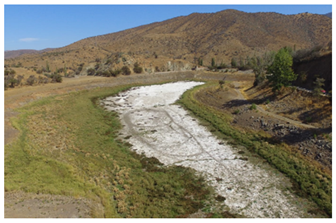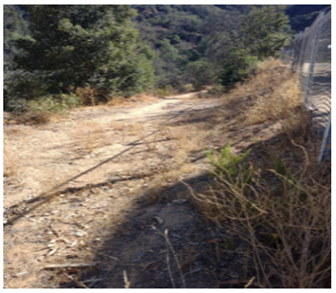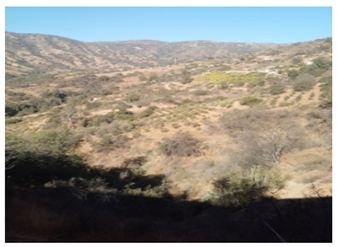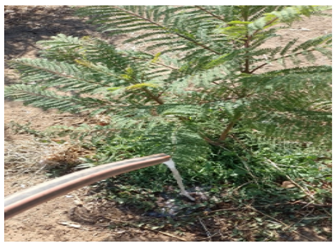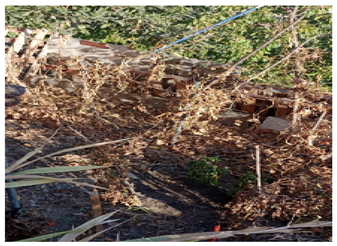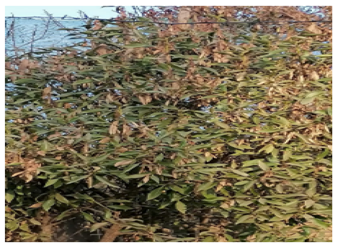Abstract
Over 1350 Chilean rural schools are experiencing a lack of potable water, and 40.4% of them lack formal access to drinking water and have to resort to various alternative sources of supply, with 43% relying on wells or waterwheels, 32% using water trucks, and 26% relying on rivers, springs, or streams. Due to the extreme situation, most inhabitants of affected rural areas count on different means of water recycling, mainly reused from irrigation, without control or management of water quality. For this study, Los Bellotos de la Vega Elementary, a rural school, became a case study as proposed by the Municipality of Olmué. The educational program focuses on crops and plantations based on rural agricultural practices, which are irrigated by a water recycling system. Through microbiological water analysis, olfactory air quality testing, surveys, and photovoice methods, we identified serious problems with the implementation and management of the water recycling system, including a lack of resources and maintenance, which could endanger the health of the members of the community. An analysis of the treatment plant’s water revealed that the recycled water did not meet quality standards, and the water supplied by water trucks was at the limits of the standards. It was also found that all the families related to the school children recycle water in their homes without any control over the quality of the water they reuse. However, a positive aspect revealed by this study is the elevated level of awareness about water conservation, habits of use, consumption, rationing, and reuse, as well as knowledge of appropriate vegetation, and they are already part of daily life.
1. Introduction
Water is an essential resource for life and is crucial for human and economic development. However, water is a limited and increasingly scarce resource due to climate change and drought. In this context, education on drought and water management is vital to ensure the sustainability of our planet; we need to change our habits and act now to protect this precious resource. In this sense, education plays a pivotal role in shaping water use behavior and building resilience to drought [1,2,3]. This research article was part of the 2021 Drought Strategic Research Fund by the National Research and Development Agency [4], project number FSEQ210038 titled “Linking the water needs of drought-affected communities with ad-hoc supply solutions: developing site-specific roadmaps with short/medium/long-term actions, focusing on conventional/non-conventional technologies”. Its goal was to achieve the following:
“Accelerate decision-making processes regarding the adoption of affordable technological solutions for sufficient and quality water supply, defining a framework, techniques, and tools to enable drought-affected communities to assemble site-specific roadmaps to address these gaps from multidisciplinary perspectives.”
Among its specific objectives, this study intended to “Define the self-assessment tools that communities have for drought management”, with a multidisciplinary perspective of the problem. This involved analyzing existing regulations, evaluating the quality of recycled water, surveying various modes of sanitary water reuse practiced by the residents of the different localities in the surroundings of Valparaiso, Chile, and determining the level of awareness regarding this issue. Studies around the world have proven that education and capacity building within communities are critical for adaptation and reducing vulnerability in the context of drought and climate resilience [5,6,7]. The selected location of the case study was an elementary rural school called “Los Bellotos de la Vega”, in Olmué, which has a school community of approximately 100 people, including students, teachers, and staff, and is part of an extended community of around 350 inhabitants. The Municipality of Olmué and the Olmué Municipal Education Administration Department proposed a study of the water management system in this rural school because, for the last 5 years, a physicochemical sanitary water recycling system has been installed as part of the scholar program that focuses on the development of crops and plantations based on local agriculture practices in rurality.
To conduct the study, both quantitative and qualitative methodologies were applied. Water samples, microbiological analysis, odor testing near the wastewater treatment plant (WWTP), and meta-analysis methods, along with questionnaires and photovoice, were used. The quantitative results were compared with existing regulations, and through the meta-analysis, the community’s usual water use and recycling practices were identified, along with their level of awareness. Based on all these results, an evaluation of the community’s water scarcity situation was carried out, and the current gaps were determined in order to generate short- and medium-term recommendations to mitigate the consequences of this issue.
2. Case Study: The Bellotos de la Vega Rural Elementary School
The Bellotos de la Vega Elementary School is located in Olmué in the Valparaiso region of central Chile, which is among hills in a completely rural and natural environment. Most students walk long distances every day to get to the school. The area has been heavily affected by drought in recent years [8,9], and the residents must rely on the water supply through the delivery of water trucks. They do not have a municipal sewer system. In general, water scarcity is a present problem that has led to the implementation of measures for the control and management of water resources, especially in rural areas. However, the control of black and gray water recycling systems remains a task pending by the government, leading to a lack of monitoring of the quality of water used and reused in different activities, mainly for irrigation. In this context, the education and maintenance of water recycling systems are presented as key tools to address this problem in rural school education. The focus of the school program in rural schools is on their territories. Therefore, for this case, the educational program focuses on crops and plantations based on local agriculture, relying on any available water reuse system for irrigation. Students must be part of an experience that contributes to their understanding of the key factors of the experienced and perceived needs and the benefits of having a designed system that addresses the identified problem, thus highlighting the importance of water in drought-prone areas, as in this case, both in the short and long term [10].
“…To achieve a change in citizens’ attitudes and behaviors, it is necessary for this change to be originated within the school itself. Education is crucial, not only to understand the relationships between natural and social systems but also to gain a clear perception of the importance of sociocultural factors in the genesis of environmental problems”. And from this perspective, another statement arises: “Environmental problems cannot be solved until it is understood that they are basically social problems derived from the values that societies and individuals hold in their daily activities […]” [11]
In this sense, it was important to work with rural elementary school students not only to uncover their usual water recycling practices but also to understand their knowledge and awareness of water conservation, crops, and the environment in general as part of their own educational projects [1].
3. Chilean Context, Standards, and Typical Water Recycling Technologies
The ANID 2021 Drought Strategic Research Fund emerged in Chile as an urgent research grant for investigating one of the most serious consequences that climate change has caused in our country [8,9]. Currently, this drought affects the most vulnerable communities, reinforcing socio-economic gaps [12,13,14]. Drought has caused havoc in the Valparaiso Region for more than 14 years [8,9]. Today, 18 of its 38 communes are under a water scarcity decree due to prolonged drought, affecting over 250 thousand people [15]. In addition to the high economic costs that this water scarcity has caused in municipalities, rural schools in these areas also suffer its consequences [12,13]. According to the study “Educating without water” conducted by the Amulen Foundation in 2019, there are more than 1350 rural schools in Chile that lack access to clean water and 40% of them do not have formal access to potable water. As a result, they have to resort to various alternative sources, with 43% relying on wells or springs, 32% on water trucks, and 26% on rivers, springs, or estuaries. The situation is so precarious that around 3% of these schools have had to cancel classes due to poor water quality or lack of water, making it impossible to conduct a normal school day, clearly lowering the education of boys and girls [16]. It is also important to consider that for those schools with formal and informal water supply, the latter perform worse in all indicators studied, reaffirming the direct relationship between water scarcity and vulnerability [17]. It is also important to consider that for those schools with formal and informal sources of water, between 45% and 48% of the principals do not know whether the supply has a sanitary resolution [16]. Regarding the information provided by the principals, teachers, and professionals in charge of rural schools with informal water supply, it is concluded that 34.6% do not. This means that more than a third of schools are not aware if the water consumed from the main source has any level of chlorination or not, while only 11.8% comply with the daily residual chlorine control, a requirement imposed by the Ministry of Health [16].
Rural enrollment in the Valparaiso region is greater than 11,000 students, and the reality with regard to the scarcity of water in schools is similar to that in the rest of the country. The Valparaiso region is one of the most affected areas, with around 31% of schools facing this problem; this undoubtedly increases inequality and early school dropout [16].
Regarding standards and norms, Chile is still precarious and needs to be reviewed and updated; there are three main regulations that we considered within this study: Law 21.623 (which amended the original Law 21.075) regulates the collection, reuse, and disposal of gray water [18,19]; the Supreme Decree D.S. 90, it decrees for the treatment of wastewater [20]; and the Chilean Standard 1333 for waters intended for recreational use with direct contact [21].
Ad hoc technologies for the recycling of gray and black water, some of the most common ones found consist of the following [22,23,24,25]:
Filtration systems (primary treatment): These systems use multimedia filters or other porous materials to remove suspended solids and contaminants from wastewater. Filtration is particularly effective for gray water, as it primarily contains low concentrations of organic matter and suspended particles.
Biological Treatment (Secondary Treatment): These systems rely on microbial activity to degrade organic contaminants in wastewater. Common biological treatment systems include extended aeration systems, which use prolonged aeration to enhance microbial degradation; activated sludge systems, where microorganisms break down organic matter in aerated tanks; constructed wetlands, which use natural plant and microbial interactions to treat wastewater; and anaerobic reactors. These systems are used primarily for black water treatment, although some, such as constructed wetlands and activated sludge, can also be adapted for gray water.
Physicochemical Treatment (Tertiary Treatment): These systems combine physical and chemical processes to remove contaminants, including suspended solids, organic matter, and dissolved pollutants. Common methods include coagulation-flocculation, which involves adding chemicals to aggregate suspended particles for easier removal; membrane separation processes, such as ultrafiltration and reverse osmosis, which effectively remove fine particles and dissolved contaminants; adsorption, using activated carbon or other adsorbents to eliminate organic and inorganic pollutants. These treatments are suitable for gray and black water, depending on the contaminant load.
Disinfection (Tertiary Treatment): The final stage of treatment involves the elimination of pathogenic microorganisms to ensure water safety. This is typically achieved through chemical disinfection, using chlorine, ozone, or hydrogen peroxide to kill bacteria and viruses; ultraviolet (UV) radiation, which destroys microbial DNA without adding chemicals to the water; and electrochemical disinfection, a less common but effective method for localized water reuse systems. Disinfection is essential before reusing treated gray and black water, particularly for applications involving human contact or irrigation.
The WWTP at the Bellotos de la Vega School corresponds to a buried horizontal system with a black water accumulation tank (T-1). The treatment system consists of a series of interconnected tanks designed for the treatment of wastewater. It begins with a primary settler (T-2), which is a yellow tank equipped with an aerator Figure 1). This tank is connected to a second tank that also features an aerator (T-3). After primary treatment, the water flows into a third sedimentation tank (T-4), followed by a chlorination tank (T-5). The water then passes through a bisulfite treatment tank (T-6) and then to a clarified water accumulation tank, which also acts as a register chamber (T-7). Finally, treated water is pumped out of the accumulation tank and used for irrigation purposes. The system was designed to efficiently process wastewater while minimizing the generation of harmful gases, such as methane and hydrogen sulfide, which can lead to odor emissions Figure 2).
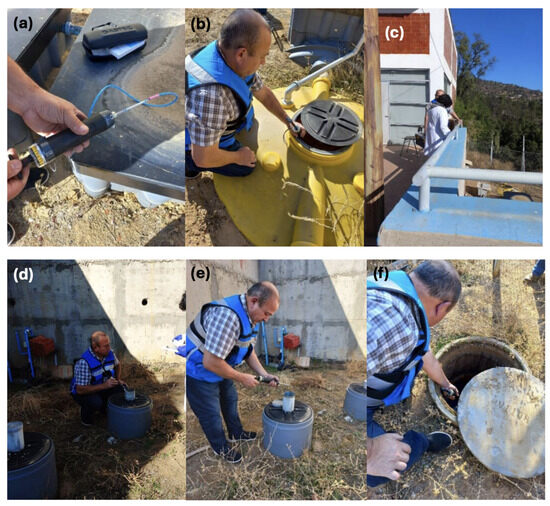
Figure 1.
Photographs of gas sampling, as described in the sequence: (a) sampling in the second settling tank; (b) sampling in the first settling tank; (c) sampling near the administration office; (d) sampling in the chlorination tank; (e) sampling in the bisulfite tank; (f) sampling in the register chamber.
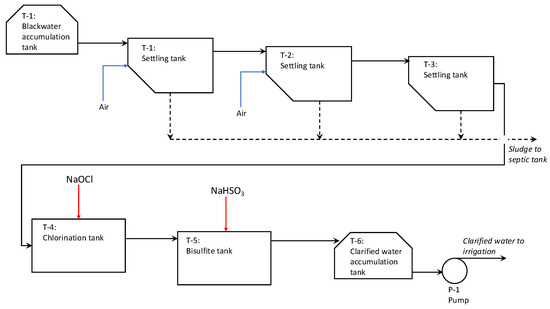
Figure 2.
Schematic of the wastewater treatment system at Bellotos de la Vega School in Olmué. The system consists of a blackwater storage tank receiving wastewater from the school (T-1), followed by three settling tanks (T-2, T-3, and T-4). These are followed by a chlorination system (T-5) and a dechlorination process using bisulfite (T-6). Finally, the treated water is stored in a last tank (T-7) before being pumped (P-1) for irrigation.
4. Materials and Methods
To effectively address the research problem and achieve our objectives, our multidisciplinary team embraced a comprehensive mixed methodology approach. This approach seamlessly blended conventional materials and tools commonly used in specialized laboratory biochemical equipment analysis with and reagents typical of analytical chemistry research. Simultaneously, we integrated innovative techniques used in social science research, allowing us to dive into the realm of human perception and awareness of the subject under investigation. By synergizing these diverse methodologies, we aimed to gain a comprehensive and nuanced understanding of the subject from both scientific and human-focused perspectives.
On the quantitative side, we sampled water and analyzed it for , pH, total nitrogen (Kjeldahl), total suspended solids, sulfate, and chloride. Microbiological analyses were performed for Total Coliforms and Escherichia coli. Finally, a gas sampling was performed to analyze the sulfur compound in air surrounding the school.
On the qualitative research front, we used audiovisual and printed resources, sharing them with children from the rural community. To encourage engagement, we assigned students a small task of capturing photos and used video cameras to record interviews while applying the participatory research method photovoice [26,27,28,29]. This technique has been widely used in community-based research to amplify marginalized voices and facilitate social change. Participants take photographs representing their realities, followed by discussions in which they interpret their images, providing context and information.
4.1. Methodological Approach in Socio-Qualitative Research
4.1.1. Previous Meetings with Teachers
Awareness among teachers was especially important but not sufficient to achieve attention and behavior modification in their students [30]. For this reason, a prior meeting is held with the school’s teachers to involve them in raising awareness about the water problem. The issue to be addressed with students was presented, along with the working methodology to be used, to help understand the key factors of the problem, such as perceived necessity and the benefits that come with making decisions for efficient water use in the short, medium, and long terms.
4.1.2. Perception Questionnaire
A perception questionnaire presented in the form of a brochure (leaflet) was designed and conducted to understand how students perceived the problem of water scarcity in their area from their own perspective. The questionnaire consisted of 28 multiple choice questions and one open question as shown in Table A1 (Appendix A), adapted to the language of elementary school students, covering six fundamental sections related to their experiences and perception. The students also responded with their ages and grades. Its application was carried out by a team of four female researchers in collaboration with school teachers, helping and guiding students when applying it (Figure 3).
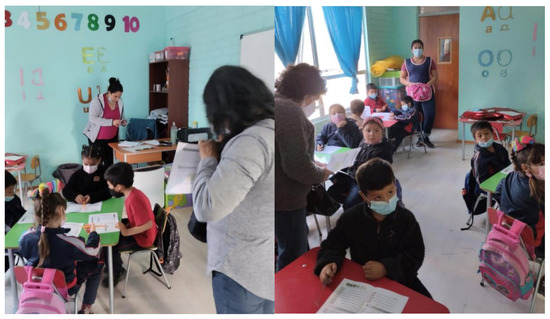
Figure 3.
Questionnaire for elementary students, who were given assistance in following and answering the questions.
4.1.3. Photovoice
Photovoice, photo voice, or photostory is a participatory research technique that combines photography and group dialogue to allow marginalized communities to speak about their experiences and challenges [26]. It acts as a way for them to document their lives and potentially catalyze change within their communities [31]. The different phases of photovoice applied to this research are described as follows:
- Topic Selection: Based on identifying possible needs or deficiencies within a community (initial approach), a theme was selected for exploration through photography.
- Participant Selection: Participants with an interest in the chosen topic, who represented the diversity of the community, were recruited. In this case, 15 students from the fourth to eighth grade who attended the rural elementary school, Los Bellotos de la Vega, Olmué, were chosen.
- Training: The participants had previously responded to the perception questionnaires described in the previous section. Participants also receive training in some photography techniques and the photovoice methodology. This includes details on the study timeline, the thematic focus (water scarcity and climate change), and their personal commitment to the project; for this case, parents needed to sign a consent/authorization form. Additionally, students are provided with a set of questions that will be addressed during the discussion sessions; these questions serve as a debate activator questionnaire, which is known by the acronym SHOWeD, conceived by Wang and Burris [32], and based on techniques of education and empowerment:
- What do you see here?
- What is really happening?
- How does it relate to our lives?
- Why does this problem or strength exist?
- What can this image teach us about it?
- What can we do about it?
- Taking photographs: Participants take photos that represent their experiences related to the chosen theme.
- Group Discussion: A discussion session was held around the taken photos. In this case, they were divided into two groups of 7 and 8 children, respectively. They shared their photos and discussed their experiences and challenges related to the theme, following a guideline.
- Analysis of Collected Material (photographs, testimonies, etc.).
4.2. Methods for Quantitative Analysis in Water and Air
Microbiological and chemical analysis was performed on recycled water obtained from the WWTP. Drinking water supplied by trucks was also sampled and analyzed. In addition, due to the obvious unpleasant odors, an olfactory study was also performed.
4.2.1. Water Quality in Wastewater Treatment Plant
Water analyses were performed to test the safety of the production of water samples from the WWTP of the Bellotos de la Vega School. analysis [33] using the electrometric method, measured with an oxygen-sensitive membrane electrode in an incubation time of 5 days at a temperature of 20 ± 1 °C. This was calculated by the difference between the dissolved oxygen at the start of the incubation period and the end of the incubation period. pH measurements were made by the potentiometry method and in the field with pH test strips. Conductivity was measured by direct measurement. For the determination of phosphorus [34], a colorimetric method was used; this involved treating the sample with HNO3/HClO4 mixture to transform the phosphorus species and measure the intensity of the color at a wavelength of 400 [nm], adding an acid (HCl) and a mixture of molybdate/ammonium metavanadate, and forming a yellow solution.
The total nitrogen content was determined using the Kjeldahl volumetric method [35], digesting the sample with sulfuric acid, copper sulfate and potassium sulfate, and by transforming organic nitrogen species into (NH4SO4, the solution obtained is distilled by adding sodium hydroxide (Kjeldahl distillation) that releases NH3, which is absorbed in an acid solution. Then nitrogen is determined by backfiltration of such an acid solution.
Total suspended solids [36] were conducted by the gravimetric method, drying the sample in an oven at 104 ± 1 °C to constant weight on a GA-55 glass fiber filter paper (Advantec). Fats and oils were analyzed using the gravimetric method (NCh 2313/6) [37]. In this method, the sample is subjected to an extraction process combining two techniques: Soxhlet apparatus and partition separation using n-hexane as solvent. Lastly, the evaporated solvent-free residue was weighed.
Sulfate analysis was performed using the turbidimetric method: The sulfates dissolved in a CH3COOH medium form uniformed sized crystals with BaCl2, causing turbidity in the solution, allowing quantification by spectrophotometry at 420 [nm], using a calibration curve of a standard sulfate stock solution (Merck, Darmstadt, Germany, 1000 [mg/L]) [38]. Chloride analysis was performed using the argentometrica method (Standard Methods 4500-Cl-B) [39]. This method consisted of using potassium chromate as an indicator, in which dissolved chlorides are quantified in a neutral or slightly alkaline solution by titrating the sample with AgNO3 solution. Chloride precipitates quantitatively as AgCl until a reddish coloration is formed due to Ag2CrO4 precipitation. The microbiological analysis [40] of the water is carried out on the effluent from the existing treatment plant at the school; the sample is collected in glass bottles, which were previously washed, then sterilized at 170 °C for 1 h as indicated in the procedures described in Standard Methods 9030 [41] and 9040 [42]. The study was performed to measure Total Coliforms and Escherichia coli determination. Fast pH tests were performed in the field using pH test strips.
4.2.2. Water Quality for Drinking
An analysis of the water consumed by students was performed to assess whether the water supplied by the water trucks meets quality standards and is safe for human consumption. These analyses aimed to identify potential health risks for students and to take appropriate measures to ensure an adequate and safe supply of drinking water in the school. The importance of water quality analysis encompasses the health and well-being of students. The quality of water that students consume daily has a direct impact on their health and well-being. The water quality analysis allowed the identification of possible contaminants or pathogens present in the water that could pose risks to the student’s health, which are not in compliance with drinking water standards; it also helps with the identification of risks that require necessary measures. The parameters that were analyzed were pH, conductivity, free chlorine, iron, manganese, and copper.
4.2.3. Detection of Sulfur Compounds in the Vicinity of the Water Treatment System
An olfactory analysis of air around the school’s treatment plant was carried out, which was examined for sulfur dioxide or hydrogen sulfide. For this purpose, a gas detector with hydrogen sulfide and sulfur dioxide detector tubes 1PK/10 (Gastec detector tubes N45S, Gastec Corporation, Ayase, Japan) was used.
Initially, gas sampling was performed from the second settling tank (T-3, Figure 1) of the wastewater treatment plant (aerator) to begin sampling the first phase of the circulation process. Subsequently, sampling was carried out in the first settling tank (T-2). The samples were then taken in the surroundings of the administration office, followed by samples taken from the chlorination tank, the bisulfate tank, and, finally, from the clarified water accumulation tank or register chamber (Figure 3).
5. Results and Discussion
5.1. Qualitative Results: Surveys and Photovoice
Regarding the results from the qualitative tools, first, from the perception questionnaire applied to sixty-eight students from a total of eighty-five kindergartens to eighth graders and six professors, a selection measured as a percentage of the most significant results to the questions in each section is included in Table A2. It is important to mention that for younger children, the application of the questionnaire was aided by an adult, and in certain cases, like kindergarten, certain sections were not considered.
Photovoice is a powerful tool that can be useful both for researchers and design professionals as they seek to understand the challenges that others are facing [26,43]. Taking this statement into account, a careful study of the images and narratives of the students was conducted. The most significant testimonies are presented in Table 1 and Table 2).

Table 1.
Part one of drought insights of students at Bellotos de La Vega School.

Table 2.
Part two of drought insights of students at Bellotos de la Vega School.
An analysis of the questionnaire and photovoice results within a community living in an area with severe water scarcity provides compelling evidence of a robust culture of concern and awareness of water conservation among both students and their families. Their proactive approach to water management and preservation is evident, demonstrating a commendable commitment to addressing the challenges posed by water scarcity. Although no student has knowledge and awareness about the drought that impacts the sector, the approach is given in a concrete way; that is, it is based mainly on the effects they can observe with the naked eye. Therefore, the need for education, not only for the group that was interviewed but also at the level of the general population, deepens their understanding of the phenomenon with a focus on three aspects:
- The impact it has had so far on their lives, as opposed to other groups of the population, for example, urban communities.
- The future projection, under current conditions, with measures that are mainly based on savings; that is to say, palliative.
- The importance of improving consumption and production practices in agriculture in order to improve the forecast for the community.
With water reuse being a habit, education about it is also worth considering, as they do not necessarily question the impact that different water sources might have on their environments. This particularly arises with regard to the reuse of domestic wastewater, a practice that has a potential risk in terms of health. From there, the installation of concepts such as water security is key.
Water conservation appears as a naturalized aspect (98% stated yes in “I must take care of the water” on the perception questionnaire); as in most cases, they have lived a significant part of their lives (if not their entire lives) in an environment that has been affected by drought. This means that in their habits of water use and consumption, rationing and reuse are topics that are ingrained in their daily lives, and they do not conceive a different way of doing things.
Therefore, education on recycling and water treatment is crucial, especially considering the material conditions of the sector: low level of urbanization and lack of sewage systems. Although the role of education is the basis, the actions should be addressed by different actors in the community, both public and private. From there, the promotion of native flora appears as a key to the care of water and the preservation of the environment, both in terms of soil quality and in the care of local biodiversity. Some key points to address are the following:
- Educate about the diversity of native flora: properties, benefits, and uses that they can have in daily life, and also for the development of local commerce.
- Raise awareness regarding the contribution they make to the local ecosystem.
- Promote the planting and responsible cultivation of native species.
The absence of clear norms and regulations, coupled with a lack of institutional and governmental responsibilities, creates a significant void in water management practices. This absence of official guidelines leaves the community grappling with uncertainty and hampers their ability to implement effective water conservation practices systematically.
In addition, the community lacks a comprehensive understanding of their potential health exposure resulting from the lack of a proper quality assessment of recycled water. The absence of stringent water quality assessment protocols raises concerns about the potential risks associated with using recycled water for various purposes. This knowledge gap underscores the need for comprehensive and regular water quality testing to safeguard the health and well-being of the community members.
5.2. Water Quality Analysis
Regarding the analysis of the water obtained from the WWTP, whose residues are discharged into streams but not used for crop irrigation, the presence of E. coli bacteria in >2419.6 NMP/100 mL and high levels of were alarmingly higher than the reference value provided by the standards, which therefore posed an imminent health risk to school residents. Table 3 shows that nitrogen, phosphorus, and potassium were within the NCh 1333 standard limits, which is considered suitable for irrigation and plant growth [21,44]. High was attributable to the presence of microorganisms and poor degradation of organic matter in the WWTP. There is a risk of biological concern, such as Norovirus transmission, as occurred in historical records in the city of Antofagasta, where 36,036 people were infected by irrigation of vegetables with contaminated water from a treatment plant [45]. There are reports in which these strains have been identified [46]. In another study of Norovirus outbreaks related to the consumption of contaminated seafood, it was found that a norovirus detected by qPCR in seafood had an average probability of infection of 29 to 40% in individuals who consumed oysters [47]. These oysters were contaminated by waste discharges in the ocean, with the virus being transported through water currents to the seafood and subsequently collected and brought to market. This indicates that even a norovirus detected by qPCR in an environmental sample has a significant probability of causing infection. The results indicate that this water is not suitable for irrigation purposes due to the high load of E. coli value and fecal coliforms. The conductivity and total suspended solids parameters being outside the range also show that the water produced by this WWTP should not be used by any crop without prior treatment that regulates the parameters outside the country’s regulations.

Table 3.
Water quality analysis of samples from the Los Bellotos de la Vega School Treatment Plant.
Initially, we focused on locating and evaluating existing water treatment systems in drought-affected areas where wastewater recycling was permitted and commonly practiced. During the selection process for our study location, we discovered that the implementation of a private sewer system and wastewater treatment is only feasible and authorized in rural areas. Simultaneously, we became aware of the alarming fact that 40% of the rural schools in Chile lack access to potable water [48]. Recognizing that rural schools are key components of their communities, we realized that they could serve as an ideal case study to accelerate decision-making processes on the adoption of affordable technological solutions for a sufficient and quality water supply. Our overarching goal was to establish a comprehensive framework, techniques, and tools for drought-affected communities. This allows us to create site-specific roadmaps that address these water-related gaps from a multidisciplinary perspective, as envisioned throughout the project. Given this context, we found the rural school of Bellotos de la Vega to be a suitable fit for our case study. It provided us with an opportunity to analyze awareness and knowledge of the academic community about drought, water use, and the quality of recycled water for irrigation, thus creating awareness of this pressing reality. The school was recommended by the Olmué Municipality and has been part of the 10.2% of rural schools located in our declared severe drought region [48] for 15 years already.
Drinking water was provided and distributed through water trucks by a private company. The results from the analysis of drinking water obtained directly from the tap are shown in Table 4. Another aspect to be discussed regarding this school is that it is among the 56.8% of Chilean rural schools that rely on informal systems for the supply of potable water, and 15.4% rely on water deliveries by water trucks [48]. Therefore, as a precaution, we conducted a microbiological analysis of the water consumed by the students, considering the events that occurred in the Coquimbo region [49], where protests erupted due to the the inadequate water supply of the water trucks, affecting more than 1000 families. Fortunately, the results showed that all parameters were within the established norms, albeit at the lower limit, such as chlorine levels being at the minimum required (0.2 mg Cl2/L), which raised concerns about this observed condition. Table 4 shows that all parameters are within the NCh 409 regulations [50], indicating that water maintains the quality standards for human consumption in the school.

Table 4.
Truck-supplied drinking water analysis results.
5.3. Air Quality
Based on the results of the perception of unpleasant smells, an olfactory measurement of hydrogen sulfide was performed in different zones of the water treatment plant. The results are presented in Table 5 Among the results, the bisulfite tank or dechlorination pond stands out, where saturation was immediate at 6 s; therefore, the sample volume could not be determined.

Table 5.
Hydrogen sulfide results in treatment plant and its vicinity.
Upon our initial visit, it quickly became evident that the water treatment system in the school was in disarray, resulting in widespread discomfort due to the odors generated by the plant. Even more troubling was the lack of an official control regulation for its operation, as indicated by the high levels of unexpected hydrogen sulfide detected in olfactory tests (Table 5).
Another notable concern is the normalization of unpleasant odors, which can serve as an indicator of underlying issues with the water treatment system. By accepting these odors as a common occurrence, the community can unknowingly overlook potential hazards and become desensitized to warning signs, which could indicate greater problems with the water infrastructure.
Addressing these challenges requires concerted efforts from both community members and relevant authorities. Implementing clear guidelines and regulations, along with improving institutional and governmental responsibilities, will pave the way for more effective water management strategies. In addition, prioritizing regular and thorough water quality assessments will ensure the safety of recycled water usage. By raising awareness and understanding the importance of identifying and addressing unpleasant odors, the community can take proactive steps to rectify water treatment issues and achieve a safer and more sustainable water supply. Through collaborative action and shared commitment, the community can strengthen its already commendable culture of water conservation and have a lasting impact on its environment and future generations.
Authors should discuss the results and how they can be interpreted from the perspective of previous studies and of the working hypotheses. The findings and their implications should be discussed in the broadest context possible. Future research directions may also be highlighted.
6. Conclusions
Severe drought conditions have led communities to adopt water reuse practices, yet there is limited awareness and evaluation of the quality of recycled water. Many households rely on informal water recycling methods, particularly using water for irrigation without fully understanding the potential risks. This study highlights the need for systematic documentation of existing practices and improved access to certified treatment technologies.
In the case of the Los Bellotos de la Vega School, an institutionally funded system has been in place for five years, yet its performance remains uncertain. Similar uncertified systems are widely available, which highlights the need for clear regulations and compliance measures. Addressing these challenges requires greater institutional involvement, particularly in rural areas where water management frameworks are often lacking.
To improve the safety of water reuse, households should have access to user-friendly monitoring tools in conjunction with awareness programs to promote best practices in water conservation and recycling. Strengthening education on sustainable water management from an early age is essential to fostering long-term resilience in drought-affected communities.
This case study underscores the importance of establishing baseline data for informed decision making in drought management. More research is needed to bridge knowledge gaps and develop effective community-driven solutions.
Author Contributions
Conceptualization, N.H.; methodology, N.H. and M.O.; validation, N.H. and P.G.-P.; formal analysis, N.H., L.C. and M.C.; investigation, L.C. and M.C.; resources, M.O. and P.G.-P.; data curation, N.H.; writing—original draft preparation, N.H. and M.C.; writing—review and editing, L.C., M.C., J.S. and P.G.-P.; visualization, L.C.; supervision, P.G.-P.; project administration, N.H.; funding acquisition, P.G.-P. All authors have read and agreed to the published version of the manuscript.
Funding
This research was funded by the National Research and Development Agency (ANID) FSEQ210038. Support from ANID PIA/APOYO AB230003 is also acknowledged.
Informed Consent Statement
This study obtained informed and signed consent from the parents, guardians, and caregivers of the participating children, strictly adhering to ethical standards applicable to research involving human subjects, particularly those concerning the participation of minors.
Data Availability Statement
The original contributions presented in this study are included in the article. Further inquiries can be directed to the corresponding author.
Conflicts of Interest
The authors declare no conflicts of interest.
Abbreviations
The following abbreviations are used in this manuscript:
| DAEM | Department of Municipal Education Administration of Olmué |
| WWT | Wastewater Treatment Plant |
| Five-day Biochemical Oxygen Demand | |
| qPCR | Quantitative Polymerase Chain Reaction |
Appendix A

Table A1.
Sections, questions, and objectives of the perception questionnaire.
Table A1.
Sections, questions, and objectives of the perception questionnaire.
| Section | Questions | Objectives |
|---|---|---|
| I. Concern about climate |
| To analyze the perception of students to the issue of climate change concerning responsible water usage. To determine the level of concern and commitment to water conservation practices in their daily lives. To identify students’ awareness and actions regarding water conservation. |
| II. Water recycling at my school |
| To understand the students’ comprehension and opinions regarding the importance and effectiveness of water recycling in the school environment. To gauge the level of knowledge, perception, and satisfaction of the users regarding the implemented water recycling system at their school. |
| III. Knowledge of water recycling technology |
| To determine the students’ familiarity and willingness to learn about water recycling technologies and methods. To gather information about the existing knowledge and/or interest to learn more about water recycling technologies. |
| IV. Perception of unpleasant odors |
| To identify if students perceive and react to the presence of unpleasant odors at their school, which originates from the water recycling system. To obtain information about individual experiences and olfactory sensitivity to unpleasant odors at school, which originate from the water recycling system. |
| V. Perception of health related to water |
| To identify if students regularly experience any discomfort or health issues while they are at school. To quantify the presence and frequency of symptoms such as stomachache, headache, dizziness, and/or nausea while in school. To establish a relationship between health symptoms experienced by students and the water recycling system installed in their school. |
| VI. Perception of water at home. Five Yes/No questions |
| To understand how the students perceive the availability, quality, and uses of water in their homes. To assess the students’ concerns about water availability at home, the sufficiency of water supply for specific uses at home, and the quality of their own water recycling systems if there are any. |
| One open-ended question | Do you have any additional comments you would like to share about the water recycling system at your school? | To allow the students to share their opinions, comments, or additional suggestions regarding the topic. To gather additional information that may not have been addressed in the previous questions. It provides the respondents with an opportunity to express their thoughts, concerns, ideas, or any other aspect they consider relevant to the water recycling system at their school. |

Table A2.
Results from perception questionnaire.
Table A2.
Results from perception questionnaire.
| Section | Questions and Answers |
|---|---|
| I. Concern about climate change. Five multiple-choice questions. | “I am concerned about Climate Change”: 82% responded positively to this concern, 14% are not worried, and 4% did not respond. |
| “We reuse water at home”: 86% of the respondents reuse water from some appliance, with 39.4% from the washing machine, 27.3% from the shower, 21.2% from the dishwasher, and 12.1% from the sink. | |
| “I try to save water as much as possible”: 92% expressed concern about water conservation and 6% are not interested. | |
| “I let the water run while brushing my teeth”: 8% admitted that they are not careful about leaving the water running while brushing their teeth, while 90% expressed concern about this. | |
| “I must take care of water”: 98% emphasized the importance of water conservation. | |
| II. Water recycling at my school. Five multiple-choice questions | “I know the system that recycles water at my school”: 74% stated that they do not know the water treatment system at school, 18% said they know it, and 8% did not respond to the question. |
| “I know ways to recycle water”: 90% claimed to know ways to recycle water, 8% do not know, and 2% did not respond to the question. | |
| “I am interested in ways to recycle water”: 92% are interested in learning about water recycling methods, 6% are not interested, and 2% did not respond. | |
| Item IV: “Perception of Bad Odors” “I sense bad odors at my school”: 72% confirmed that they do sense bad odors, while 24% stated that they do not, and 4% did not respond to the question. | |
| “Where does the bad odor in my school come from?” 50% mentioned that it comes from the wastewater recycling system, 46.6% said it comes from the bathrooms, and the rest did not respond. | |
| III. Knowledge of water recycling technology. Two multiple-choice questions | “I know ways to recycle water”: 90% claimed to know ways to recycle water, 8% do not know. |
| “I am interested in ways to recycle water”: 92% are interested in learning about water recycling methods and 6% are not interested. | |
| IV. Perception of unpleasant odors | “We use recycled water to water plants”: 86% affirmed that they reuse water at home for watering plants, 10% do not, and 4% did not respond. |
| V. Nine multiple-choice questions | “Where does the bad odor in my school come from?” 50% mentioned that it comes from the water recycling system, 46.6% said it comes from the bathrooms, and the rest did not respond. |
| VI. Perception of water at home | “We use recycled water to water plants”: 86% affirmed that they reuse water at home for watering plants, 10% do not, and 4% did not respond. |
| One open-ended question | Question regarding “the water recycling system at your school” students repeatedly mentioned: “It doesn’t work”, “There’s a lot of smell”, “I’ve gotten used to it”, “They should fix it”, “It’s very foul-smelling”. |
References
- McCarroll, M.; Hamann, H. What We Know about Water: A Water Literacy Review. Water 2020, 12, 2803. [Google Scholar] [CrossRef]
- Thompson, R.; Serna, V. Empirical evidence in support of a research-informed water conservation education program. Appl. Environ. Educ. Commun. 2016, 15, 30–44. [Google Scholar]
- Water Corporation. Water Corporation: Managing Water Resources in a Changing Climate. 2023. Available online: https://www.watercorporation.com.au/ (accessed on 27 January 2025).
- Agencia Nacional de Investigación y Desarrollo (ANID). Concurso Fondo de Investigación Estratégica en Sequía 2021; Agencia Nacional de Investigación y Desarrollo: Santiago, Chile, 2021. [Google Scholar]
- Alliance for Water Efficiency; Institute for Sustainable Futures; Pacific Institute. Managing Drought: Learning from Australia’s Millennium Drought; Alliance for Water Efficiency: Chicago, IL, USA, 2016. [Google Scholar]
- Wens, M.L.; Van Loon, A.F.; Veldkamp, T.I.; Aerts, J.C. Education, financial aid, and awareness can reduce smallholder farmers’ vulnerability to drought under climate change. Nat. Hazards Earth Syst. Sci. 2022, 22, 1201–1232. [Google Scholar]
- UNDP Drylands Development Centre. Community Based Resilience Analysis in Kenya and Uganda; Technical Report; United Nations Development Programme (UNDP): New York, NY, USA, 2013. [Google Scholar]
- NASA Earth Observatory. Atmospheric Rivers Swamp Central Chile; NASA Earth Observatory: Greenbelt, MD, USA, 2023. [Google Scholar]
- Delano, J.W. More than a Decade of Megadrought Brought a Summer of Megafires to Chile; Inside Climate News: Brooklyn, NY, USA, 2023. [Google Scholar]
- Jeffrey, P.; Temple, C. Sustainable Water Management: Some Technological and Social Dimensions of Water Recycling. Sustain. Dev. Int. 1999, 1, 63–66. [Google Scholar]
- Marcén Albero, C.; Molina Herranz, P.J. La Persistencia de las Opiniones de los Escolares Sobre el Medio Ambiente. una Particular Visión Retrospectiva Desde 1980 a 2005; CNEAM: Valsaín, Spain, 2006. [Google Scholar]
- Bouye, M. Chile’s Protests Offer Lessons on Social Inequality and Climate Action; World Resources Institute: Washington, DC, USA, 2020. [Google Scholar]
- Rodríguez, C.; Serrano, J.; Sánchez, R.; Leiva, E. The Hydrosocial Cycle and the Inequalities in Access to Water in Rural Areas of Metropolitan Region of Santiago, Chile. Water 2024, 16, 2811. [Google Scholar] [CrossRef]
- Juárez-Lucas, A.; Perez, L.C.; Mizrav, H.C. A Closer Look at Droughts in Latin America and the Caribbean; The World Bank Group: Washington, DC, USA, 2024. [Google Scholar]
- La Tercera. 58 Comunas del País Están Bajo Decreto de Escasez Hídrica; La Tercera: Santiago, Chile, 2025. [Google Scholar]
- Pobres de Agua: Radiografía del Agua Rural en Chile; Centro Cambio Global: Santiago, Chile, 2019.
- Carrão, H.; Naumann, G.; Barbosa, P. Mapping global patterns of drought risk: An empirical framework based on sub-national estimates of hazard, exposure and vulnerability. Glob. Environ. Chang. 2016, 39, 108–124. [Google Scholar]
- Ministerio de Obras Públicas. Ley N° 21.075: Regula la Recolección, Reutilización y Disposición de Aguas Grises; Technical Report; Ministerio de Obras Públicas: Santiago, Chile, 2018. [Google Scholar]
- del Medio Ambiente, M. Ley N° 21.623: Modifica la Ley N° 21.075, que Regula la Recolección, Reutilización y Disposición de Aguas Grises, para Fomentar la Reutilización de Aguas Grises Tratadas en la Agricultura; Technical Report; Ministerio del Medio Ambiente: Santiago, Chile, 2023; Available online: https://www.bcn.cl/leychile (accessed on 1 March 2025).
- Ministerio del Medio Ambiente. Decreto Supremo N° 90: Establece Norma de Emisión Para la Regulación de Contaminantes Asociados a las Descargas de Residuos líQuidos a Aguas Marinas y Continentales Superficiales; Technical Report; Gobierno de Chile: Santiago, Chile, 2000. [Google Scholar]
- INN. Norma Chilena (NCh) 1333. Requisitos de Calidad de Agua Para Diferentes Usos; Instituto Nacional de Normalización: Santiago, Chile, 1978; p. 15. [Google Scholar]
- Tilley, E.; Ulrich, L.; Lüthi, C.; Reymond, P.; Schertenleib, R.; Zurbrügg, C. Compendium of Sanitation Systems and Technologies, 2nd rev. ed.; Swiss Federal Institute of Aquatic Science and Technology (Eawag): Dübendorf, Switzerland, 2014; Available online: https://www.eawag.ch/fileadmin/Domain1/Abteilungen/sandec/schwerpunkte/sesp/CLUES/Compendium_2nd_pdfs/Compendium_2nd_Ed_Lowres_1p.pdf (accessed on 1 March 2025).
- Vera-Puerto, I.; Valdés, H.; Bueno, M.; Correa, C.; Olave, J.; Carrasco-Benavides, M.; Schiappacasse, F.; Arias, C.A. Reclamation of Treated Wastewater for Irrigation in Chile: Perspectives of the Current State and Challenges. Water 2022, 14, 627. [Google Scholar] [CrossRef]
- Khajv, M.; Mostafazadeh, A.K.; Drogui, P.; Tyagi, R.D. Management of Greywater: Environmental Impact, Treatment, Resource Recovery, and Sustainable Reuse. Water Sci. Technol. 2022, 86, 909–928. [Google Scholar] [CrossRef]
- Suez Water Handbook. El Trebal Mapocho Wastewater Treatment Plant, Chile; Suez Water Handbook: Paris, France, 2022. [Google Scholar]
- Wang, C.; Burris, M.A. Photovoice: Concept, Methodology, and Use for Participatory Needs Assessment. Health Educ. Behav. 1997, 24, 369–387. [Google Scholar] [CrossRef] [PubMed]
- Sands, C.; Reed, L.E.; Harper, K.; Shar, M. A photovoice participatory evaluation of a school gardening program through the eyes of fifth graders. Pract. Anthropol. 2009, 31, 15–20. [Google Scholar]
- Baldwin, C.; Chandler, L. “At the water’s edge”: Community voices on climate change. Local Environ. 2010, 15, 637–649. [Google Scholar]
- Wang, C.C. Youth Participation in Photovoice as a Strategy for Community Change. J. Community Pract. 2006, 14, 147–161. [Google Scholar] [CrossRef]
- Jaén García, M.; Palop Navarro, E. ¿ Qué Piensan y cómo Dicen Que actúan los Alumnos y Profesores de un Centro de Educación Secundaria Sobre la Gestión del Agua, la Energía y los Residuos? Enseñanza de las Ciencias: Barcelona, Spain, 2011. [Google Scholar]
- Powers, M.C.F.; Freedman, D.A. Applying a Social Justice Framework to Photovoice Research on Environmental Issues. Crit. Soc. Work 2019, 13, 80–100. [Google Scholar] [CrossRef]
- Wang, C.; Burris, M.A. Empowerment through photo novella: Portraits of participation. Health Educ. Q. 1994, 21, 171–186. [Google Scholar] [CrossRef] [PubMed]
- Instituto Nacional de Normalización (INN). Aguas residuales—Métodos de Análisis—Parte 5: Determinación de la Demanda Bioquímica de Oxígeno (DBO5). In Declarada Norma Oficial de la República mediante el Decreto Supremo Nº 146 de 1996 del Ministerio de Obras Públicas; Instituto Nacional de Normalización (INN): Santiago, Chile, 2005. [Google Scholar]
- Instituto Nacional de Normalización (INN). Aguas residuales—Métodos de análisis—Parte 15: Determinación de fósforo total. In Declarada Norma Oficial de la República mediante el Decreto Supremo Nº 949 de 1997 del Ministerio de Obras Públicas; Instituto Nacional de Normalización (INN): Santiago, Chile, 2009. [Google Scholar]
- Instituto Nacional de Normalización (INN). Aguas residuales—Métodos de análisis—Parte 28: Determinación de nitrógeno Kjeldahl. In Declarada Norma Oficial de la República Mediante el Decreto Supremo Nº 2557 de 1998 del Ministerio de Obras Públicas; Instituto Nacional de Normalización (INN): Santiago, Chile, 2009. [Google Scholar]
- American Public Health Association (APHA); American Water Works Association (AWWA); Water Environment Federation (WEF). Standard Methods for the Examination of Water and Wastewater: Method 2540 B—Total Solids Dried at 103–105 °C; American Public Health Association (APHA); American Water Works Association (AWWA); Water Environment Federation (WEF): Washington, DC, USA, 2017. [Google Scholar]
- Instituto Nacional de Normalización (INN). Aguas residuales—Métodos de análisis—Parte 6: Determinación de aceites y grasas. In Declarada Norma Oficial de la República mediante el Decreto Supremo Nº 317 de 1997 del Ministerio de Obras Públicas; Instituto Nacional de Normalización (INN): Santiago, Chile, 2015. [Google Scholar]
- American Public Health Association (APHA); American Water Works Association (AWWA); Water Environment Federation (WEF). Standard Methods for the Examination of Water and Wastewater: Method 4500-SO42- Sulfate; American Public Health Association (APHA); American Water Works Association (AWWA); Water Environment Federation (WEF): Washington, DC, USA, 2017. [Google Scholar]
- American Public Health Association (APHA); American Water Works Association (AWWA); Water Environment Federation (WEF). Standard Methods for the Examination of Water and Wastewater: Method 4500-Cl B—Chlorine (Residual) by Iodometric Method I; American Public Health Association (APHA); American Water Works Association (AWWA); Water Environment Federation (WEF): Washington, DC, USA, 2017. [Google Scholar]
- American Public Health Association (APHA); American Water Works Association (AWWA); Water Environment Federation (WEF). Standard Methods for the Examination of Water and Wastewater: Method 9060 A—Samples: Collection; American Public Health Association (APHA); American Water Works Association (AWWA); Water Environment Federation (WEF): Washington, DC, USA, 2017. [Google Scholar]
- American Public Health Association (APHA); American Water Works Association (AWWA); Water Environment Federation (WEF). Standard Methods for the Examination of Water and Wastewater: Method 9030—Laboratory Apparatus; American Public Health Association (APHA); American Water Works Association (AWWA); Water Environment Federation (WEF): Washington, DC, USA, 2017. [Google Scholar]
- American Public Health Association (APHA); American Water Works Association (AWWA); Water Environment Federation (WEF). Standard Methods for the Examination of Water and Wastewater: Method 9040—Washing and Sterilization; American Public Health Association (APHA); American Water Works Association (AWWA); Water Environment Federation (WEF): Washington, DC, USA, 2017. [Google Scholar]
- Kile, M. Uncovering social issues through photovoice: A comprehensive methodology. HERD Health Environ. Res. Des. J. 2022, 15, 29–35. [Google Scholar] [CrossRef] [PubMed]
- Álvaro, G.J. El fósforo y su Importancia en el Crecimiento Vegetal; Sembralia: Zaragoza, Spain, 2019. [Google Scholar]
- Instituto de Salud Pública de Chile. Detección de Norovirus en Muestras de Agua de la Ciudad de Antofagasta—Chile; Año 2010; Instituto de Salud Pública de Chile: Santiago, Chile, 2010. [Google Scholar]
- Kitajima, M.; Rachmadi, A.T.; Iker, B.C.; Haramoto, E.; Gerba, C.P. Genetically distinct genogroup IV norovirus strains identified in wastewater. Arch. Virol. 2016, 161, 3521–3525. [Google Scholar] [CrossRef] [PubMed]
- Thebault, A.; Teunis, P.F.; Le Pendu, J.; Le Guyader, F.S.; Denis, J.B. Infectivity of GI and GII noroviruses established from oyster related outbreaks. Epidemics 2013, 5, 98–110. [Google Scholar] [PubMed]
- Amulén. Educar Sin Agua, Una Realidad Invisible; La Tercera: Santiago, Chile, 2021. [Google Scholar]
- Litoralpress. Protest Over Poor-Quality Water Delivered by Trucks and Lack of Sewerage. 2025. Available online: https://www.litoralpress.cl/sitio/Prensa_Texto?LPKey=QPDHC444ZJGV4NCWMJGYBXUL3IPPQH2XELX336F6O2UW4MFKIZEA (accessed on 5 March 2025).
- División de Normas del Instituto Nacional de Normalización. NCh409/1.Of84 Agua Potable—Parte 1: Requisitos; División de Normas del Instituto Nacional de Normalización: Santiago, Chile, 2005; p. 13. [Google Scholar]
Disclaimer/Publisher’s Note: The statements, opinions and data contained in all publications are solely those of the individual author(s) and contributor(s) and not of MDPI and/or the editor(s). MDPI and/or the editor(s) disclaim responsibility for any injury to people or property resulting from any ideas, methods, instructions or products referred to in the content. |
© 2025 by the authors. Licensee MDPI, Basel, Switzerland. This article is an open access article distributed under the terms and conditions of the Creative Commons Attribution (CC BY) license (https://creativecommons.org/licenses/by/4.0/).
